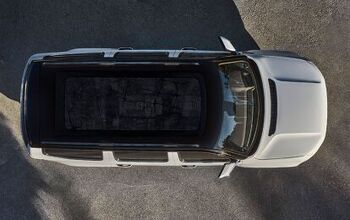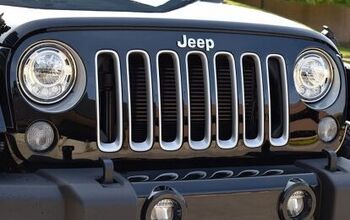Jeep Grand Wagoneer Update: This Could Go On for a While…

Clearly deciding that the protracted teaser campaign leading up to the debut of the Dodge Challenger SRT Demon was a template worthy of another go-round, Fiat Chrysler continues dropping sly suggestions of its upcoming full-size Jeep. In the absence of a defined reveal date, this could go on forever.
It already feels like it has.
— Jeep (@Jeep) August 14, 2020
Well, at least we know the upcoming Ram 1500-based SUV will feature its name somewhere on the outside of the vehicle. Interesting feature, that. Thanks to images tweeted out by Jeep on Friday, we can also see that the badging comes with an arguably gaudy gold finish, complete with a little American flag.
Make no mistake, this vehicle hails from Warren, not Mexico.
There’ll also be a way of starting up the engine from the inside of the vehicle. A push-button ignition will appear in this three-row vehicle, which is expected to top out north of $100k. Built alongside its lesser sibling, the Wagoneer, starting in the second quarter of 2021, the Michigan-built Grand Wagoneer is something Jeep should have had on the market at least a couple of years ago.
Still, better late than never, as the North American new vehicle market isn’t like Europe’s, where consumer trends are reversed almost overnight at the stroke of a lawmaker’s pen. As we told you already, the full-size SUV market in the U.S. is remarkably resilient.
While one could picture Jeep throwing out furtive glimpses and teasers for the rest of the year, the current week has already seen two such mini-reveals. That’s quite a pace to keep up. Expect a debut within the next couple of months, and perhaps a lot sooner than you think.
Of course, Jeep could choose to make its Grand Wagoneer the star of November’s L.A. Auto Show, but there’s no way that still-uncancelled show’s happening, given the virus situation.
[Image: Jeep]

More by Steph Willems
Latest Car Reviews
Read moreLatest Product Reviews
Read moreRecent Comments
- Jalop1991 In a manner similar to PHEV being the correct answer, I declare RPVs to be the correct answer here.We're doing it with certain aircraft; why not with cars on the ground, using hardware and tools like Telsa's "FSD" or GM's "SuperCruise" as the base?Take the local Uber driver out of the car, and put him in a professional centralized environment from where he drives me around. The system and the individual car can have awareness as well as gates, but he's responsible for the driving.Put the tech into my car, and let me buy it as needed. I need someone else to drive me home; hit the button and voila, I've hired a driver for the moment. I don't want to drive 11 hours to my vacation spot; hire the remote pilot for that. When I get there, I have my car and he's still at his normal location, piloting cars for other people.The system would allow for driver rest period, like what's required for truckers, so I might end up with multiple people driving me to the coast. I don't care. And they don't have to be physically with me, therefore they can be way cheaper.Charge taxi-type per-mile rates. For long drives, offer per-trip rates. Offer subscriptions, including miles/hours. Whatever.(And for grins, dress the remote pilots all as Johnnie.)Start this out with big rigs. Take the trucker away from the long haul driving, and let him be there for emergencies and the short haul parts of the trip.And in a manner similar to PHEVs being discredited, I fully expect to be razzed for this brilliant idea (not unlike how Alan Kay wasn't recognized until many many years later for his Dynabook vision).
- B-BodyBuick84 Not afraid of AV's as I highly doubt they will ever be %100 viable for our roads. Stop-and-go downtown city or rush hour highway traffic? I can see that, but otherwise there's simply too many variables. Bad weather conditions, faded road lines or markings, reflective surfaces with glare, etc. There's also the issue of cultural norms. About a decade ago there was actually an online test called 'The Morality Machine' one could do online where you were in control of an AV and choose what action to take when a crash was inevitable. I think something like 2.5 million people across the world participated? For example, do you hit and most likely kill the elderly couple strolling across the crosswalk or crash the vehicle into a cement barrier and almost certainly cause the death of the vehicle occupants? What if it's a parent and child? In N. America 98% of people choose to hit the elderly couple and save themselves while in Asia, the exact opposite happened where 98% choose to hit the parent and child. Why? Cultural differences. Asia puts a lot of emphasis on respecting their elderly while N. America has a culture of 'save/ protect the children'. Are these AV's going to respect that culture? Is a VW Jetta or Buick Envision AV going to have different programming depending on whether it's sold in Canada or Taiwan? how's that going to effect legislation and legal battles when a crash inevitibly does happen? These are the true barriers to mass AV adoption, and in the 10 years since that test came out, there has been zero answers or progress on this matter. So no, I'm not afraid of AV's simply because with the exception of a few specific situations, most avenues are going to prove to be a dead-end for automakers.
- Mike Bradley Autonomous cars were developed in Silicon Valley. For new products there, the standard business plan is to put a barely-functioning product on the market right away and wait for the early-adopter customers to find the flaws. That's exactly what's happened. Detroit's plan is pretty much the opposite, but Detroit isn't developing this product. That's why dealers, for instance, haven't been trained in the cars.
- Dartman https://apnews.com/article/artificial-intelligence-fighter-jets-air-force-6a1100c96a73ca9b7f41cbd6a2753fdaAutonomous/Ai is here now. The question is implementation and acceptance.
- FreedMike If Dodge were smart - and I don't think they are - they'd spend their money refreshing and reworking the Durango (which I think is entering model year 3,221), versus going down the same "stuff 'em full of motor and give 'em cool new paint options" path. That's the approach they used with the Charger and Challenger, and both those models are dead. The Durango is still a strong product in a strong market; why not keep it fresher?


































Comments
Join the conversation
As I've said before, Chrysler has continually dropped the large SUV ball. There should have been a Ram-based Suburban competitor in 1995. Here we are, TWENTY FIVE years later, and they still don't have a full-size SUV. The Wagoneer name has grown dust alongside the Grand, and Ramcharger which would be the Tahoe Sport entry. Shocking incompetence. But hey, at least we had all those other great Chrysler products 1995-2008.
Uh, I hope the stars and stripes won't be on export market vehicles.